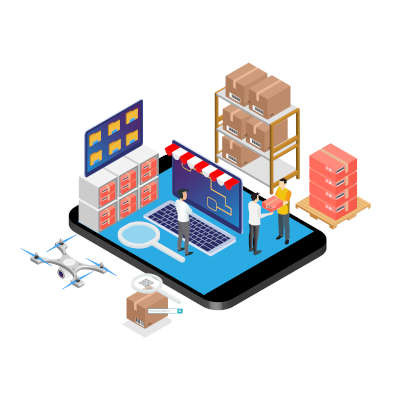SouthBridge Consulting Blog
In today’s ever-connected world, many devices are capable of utilizing an Internet connection to share and access information, including some rather unorthodox ones. All of these devices contribute to the greater collective which is referred to as the Internet of Things. While this type of unprecedented connectivity can be a great boon for businesses, it also represents great risks for business owners who do not take it seriously.
For decades, technology has been the driving force behind some of the biggest and most radical shifts in business. Therefore, it makes sense to assume that the keys to your organization pushing past its limits and becoming truly exceptional lies in the implementation of new technologies that change operations in a profound way. The process of digital transformation does not have to be difficult, but it is important in a business environment so that you can stay competitive.
Most of us take streaming media for granted. Whether you are streaming a movie on Netflix, binge-watching a show on Hulu, or using one of the growing number of streaming television networks to stream sports, shows, and news, there is quite a bit of interesting technology fueling your entertainment. Today, we thought we’d briefly go through some of the tech that makes these streaming services, and their millions of simultaneous streaming feeds, possible.
To say someone is adept at a task is to say that they are a professional, or someone with a considerable amount of knowledge that contributes to their ability to complete a particular task. In cybersecurity, this is extremely important, as the entire concept of cybersecurity is complex by nature. Your business too can improve its cybersecurity practices and shift focus to a more mindful approach to network security.
Small businesses often struggle with technology, primarily because they either lack strong IT leadership or they lack the resources to ensure IT maintenance and management happens without a hitch. There are several mistakes that a small business can make when it comes to technology management. Here are four of the biggest and most common that you absolutely cannot afford to make.
You may have been in a position where you tried to implement a technology solution in the past only to find that your staff is simply not responsive to it in any capacity. Maybe they do not see the value in the solution, or they do not understand what issues the solution resolves for your organization. To help you instill the correct mindset in your employees regarding technology, here are some training tips!
We believe that at the end of the day, employees want to do the right thing and accomplish their daily tasks without incident. However, technology can often break these plans with unexpected issues that prevent them from doing so. If you don’t take the time to provide the proper IT support when it is needed, you force your employees to either be unproductive or find unconventional (and often unsecure) solutions.
A lot has been made about 5G and the way that it is going to significantly alter what is possible, without much mention about the other technology that will fuel this complete digital transformation. We thought that we would talk a little bit about smart technology, how your business can use it to your advantage, and what this technology needs to do to be ready for the world to come.
With the onset of the COVID-19 pandemic, many organizations were forced to transition to remote work, even though they would have preferred to keep operations within the office. While the transition was rough at first, these organizations may have found that remote work offers certain flexibilities that were impossible in the traditional office environment. That said, one looming threat was (and still is) a major concern for the remote workplace: security.
When you are looking to implement new technology solutions for your business, the last thing you should do is skip the planning process. You need to carefully consider all of your options, your business’ specific needs, and the various benefits that can come from all of these options. Today we will discuss how your business can choose the best technology that suits your organization and its operations.
For some companies, their IT is like a boat to a fisherman: they could conceivably do the work without it, but they wouldn’t have a business. For this reason it is important to know how to ascertain which technology investments are right for your business at any given time. Let’s go through a few considerations decision makers should highlight when choosing new technology for their businesses.
Many professionals see the word “informatics” and think of one of two things. First, what the heck is it? Second, isn’t that just computer science? While the two certainly are similar and often used interchangeably, they are quite different. Let’s take a deeper dive and see what the field of informatics entails, how it can be applied to computer science and business, and why it’s important to consider for your organization.
Businesses use technology to varying degrees, but even small businesses have a lot of technology that must be tracked on a daily basis. With so many devices floating around the office, how are you making sure that you know who has which device, when it was issued, and how it’s being used? We suppose the question is not “how” you are keeping track of it all, but “if.” For this task, we recommend implementing an inventory tracking system for your business’ technological assets.
When we talk about the cloud, what springs to your mind? The cloud might sound like a business buzzword, but in reality it’s one of the most important components of a technology infrastructure, especially in today’s online environment. Considering the ongoing pandemic and unpredictability that the situation brings, you don’t want to wait any longer; you should have started thinking about implementing the cloud yesterday.
Artificial intelligence has taken the world by storm, and the advent of emerging technologies has many small businesses thinking about how they can utilize it to cut costs, improve operations, and eliminate unnecessary or repetitive tasks. Let’s take a look at three ways your business can leverage artificial intelligence to the best of its ability.
By now you’ve heard of VoIP (Voice over Internet Protocol), the telephone system that runs through your Internet connection rather than a phone line. VoIP can save your business up to 60 percent off your current phone bill. What many people don’t know—even ones that utilize a VoIP platform—is that there are many available options that can have major benefits for your business. Companies that have VoIP typically only use between one-third and one-half of the available options. Today, we wanted to showcase five VoIP features that you may not be taking advantage of.
Software runs our lives. It certainly runs your business. What if I told you that this essential cog in your business’ operations can also be the thing that is most susceptible to being exposed by outside attackers? It’s true, software can be the very door that hackers and scammers need to get into your network and run amok. Let’s take a look at the unsung service that is patch management and why it is so important.
A lot of business is being conducted over the Internet right now, in terms of communication and transactions alike, which makes a business’ capability to remain connected to its clientele even more important. Now is not the time to wonder if your business is as connected as it should be, which means that you need to know how much bandwidth you have available—and that what you do have is sufficient.




















